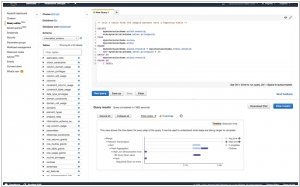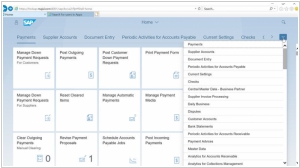Amazon Redshift vs SAP HANA
May 26, 2023 | Author: Michael Stromann
12

Amazon Redshift is a fast, fully managed, petabyte-scale data warehouse service that makes it simple and cost-effective to efficiently analyze all your data using your existing business intelligence tools. You can start small for just $0.25 per hour with no commitments or upfront costs and scale to a petabyte or more for $1,000 per terabyte per year, less than a tenth of most other data warehousing solutions.
See also:
Top 10 Big Data platforms
Top 10 Big Data platforms
Amazon Redshift and SAP HANA are both popular data management platforms, but they have distinct differences in terms of their architecture, features, and target use cases.
1. Architecture: Amazon Redshift is a fully managed data warehousing service that uses columnar storage and massively parallel processing (MPP) architecture. It is designed for processing large volumes of structured data and is optimized for high-performance analytics and reporting. SAP HANA, on the other hand, is an in-memory computing platform that combines a high-performance database with advanced analytics capabilities. It stores data in memory for faster access and processing, enabling real-time analytics and complex data modeling.
2. Features: Amazon Redshift offers a range of features tailored for data warehousing, including automatic scaling, columnar compression, and query optimization. It integrates well with other AWS services and provides seamless data ingestion and integration capabilities. SAP HANA, on the other hand, offers not only a high-performance database but also advanced analytics, data integration, and application development tools. It supports real-time data processing, predictive analytics, and machine learning algorithms, enabling more advanced data-driven applications.
3. Use Cases: Amazon Redshift is primarily used for large-scale analytics and reporting in scenarios where organizations need to process and analyze massive amounts of structured data. It is commonly used in business intelligence, data warehousing, and ad-hoc querying. SAP HANA, on the other hand, is designed for real-time analytics, operational reporting, and transactional processing. It is often utilized in industries such as finance, manufacturing, and retail, where immediate insights and real-time decision-making are crucial.
4. Ecosystem and Integration: Amazon Redshift is part of the larger AWS ecosystem, which provides a comprehensive suite of cloud services. It integrates well with other AWS services such as S3, Glue, and Lambda, allowing seamless data integration, transformation, and processing. SAP HANA, on the other hand, is a part of the SAP ecosystem, which includes various enterprise applications and tools. It offers tight integration with SAP's business suite applications, providing end-to-end data processing and analysis capabilities.
5. Deployment and Management: Amazon Redshift is a fully managed service that handles infrastructure provisioning, scaling, backups, and maintenance tasks. Users can focus on data analysis and queries without worrying about infrastructure management. SAP HANA can be deployed on-premises or in the cloud, and organizations have more control over the deployment and management of the system. It requires expertise in SAP HANA administration for efficient management and optimization.
See also: Top 10 Big Data platforms
1. Architecture: Amazon Redshift is a fully managed data warehousing service that uses columnar storage and massively parallel processing (MPP) architecture. It is designed for processing large volumes of structured data and is optimized for high-performance analytics and reporting. SAP HANA, on the other hand, is an in-memory computing platform that combines a high-performance database with advanced analytics capabilities. It stores data in memory for faster access and processing, enabling real-time analytics and complex data modeling.
2. Features: Amazon Redshift offers a range of features tailored for data warehousing, including automatic scaling, columnar compression, and query optimization. It integrates well with other AWS services and provides seamless data ingestion and integration capabilities. SAP HANA, on the other hand, offers not only a high-performance database but also advanced analytics, data integration, and application development tools. It supports real-time data processing, predictive analytics, and machine learning algorithms, enabling more advanced data-driven applications.
3. Use Cases: Amazon Redshift is primarily used for large-scale analytics and reporting in scenarios where organizations need to process and analyze massive amounts of structured data. It is commonly used in business intelligence, data warehousing, and ad-hoc querying. SAP HANA, on the other hand, is designed for real-time analytics, operational reporting, and transactional processing. It is often utilized in industries such as finance, manufacturing, and retail, where immediate insights and real-time decision-making are crucial.
4. Ecosystem and Integration: Amazon Redshift is part of the larger AWS ecosystem, which provides a comprehensive suite of cloud services. It integrates well with other AWS services such as S3, Glue, and Lambda, allowing seamless data integration, transformation, and processing. SAP HANA, on the other hand, is a part of the SAP ecosystem, which includes various enterprise applications and tools. It offers tight integration with SAP's business suite applications, providing end-to-end data processing and analysis capabilities.
5. Deployment and Management: Amazon Redshift is a fully managed service that handles infrastructure provisioning, scaling, backups, and maintenance tasks. Users can focus on data analysis and queries without worrying about infrastructure management. SAP HANA can be deployed on-premises or in the cloud, and organizations have more control over the deployment and management of the system. It requires expertise in SAP HANA administration for efficient management and optimization.
See also: Top 10 Big Data platforms
Amazon Redshift vs SAP HANA in our news:
2014. SAP and IBM partner to provide SAP HANA on IBM Cloud

The software giants SAP and IBM have joined hands and announced the availability of the HANA Enterprise Cloud service, a Big Data platform, through IBM's cloud infrastructure. SAP CEO Bill McDermott acknowledged the immense demand for SAP HANA in the cloud and described the global agreement with IBM as marking a new era of cloud collaboration. IBM CEO Ginni Rometty highlighted this as a significant milestone in the deployment of enterprise cloud, emphasizing that IBM's secure, open, and hybrid enterprise cloud platform will enable SAP clients to embrace new ways of working in an era shaped by big data, mobile, and social advancements.
2014. SAP: Germany won the World Cup thanks to Big Data
In the not-too-distant past, the Oracle yacht emerged victorious in the America's Cup. Subsequently, Oracle marketers attributed this achievement to the utilization of Oracle's Big Data system. Now, it's SAP's turn (Oracle's perennial rival) to respond to this marketing claim. As it turns out, the German football team's triumph in the World Cup can also be attributed to a Big Data system called SAP Match Insights, which operates on the innovative SAP HANA technology. This system synchronized data from scouts with video footage captured on the field, enabling coaches to easily identify crucial moments during the game. By leveraging SAP Match Insights and SAP HANA, the coaches of the German National Team simplified their training methods and improved performance, thereby enhancing the beauty of the sport for fans worldwide. This story serves as a reminder of the transformative potential of Big Data for businesses.
2013. SAP makes big companies effective with Big Data. Competitors are crying
In recent years, SAP was probably the least innovative IT giant (compared to competitors Oracle, Microsoft, IBM). All SAP's own innovative projects mostly failed (remember Business ByDesign), and the only thing that SAP could do - is buying other companies (SuccessFactors, SyBase, Ariba). But at this time, SAP is going to outdo all the competitors on the wave of new trendy technology - Big Data. What is Big Data? ***






